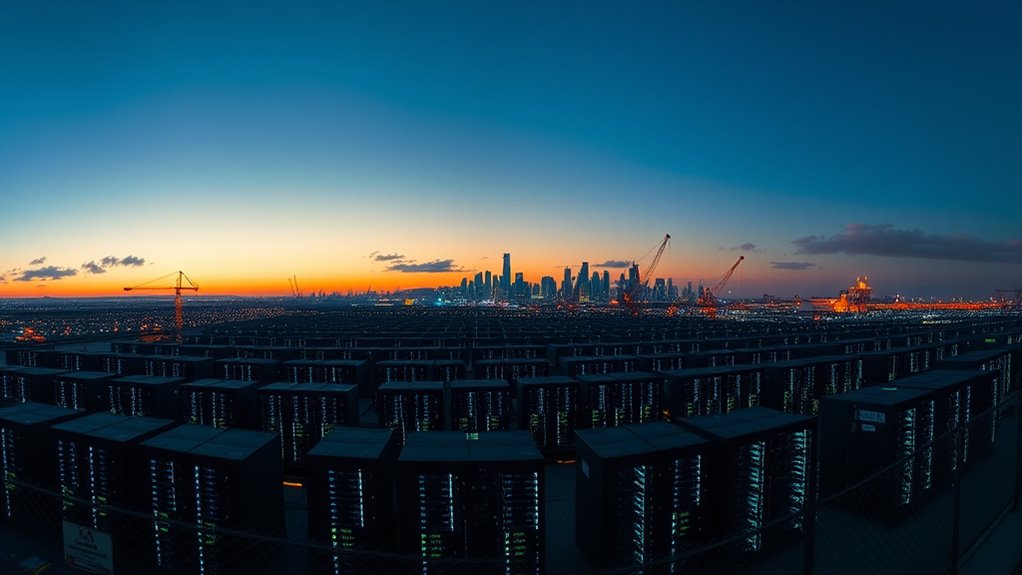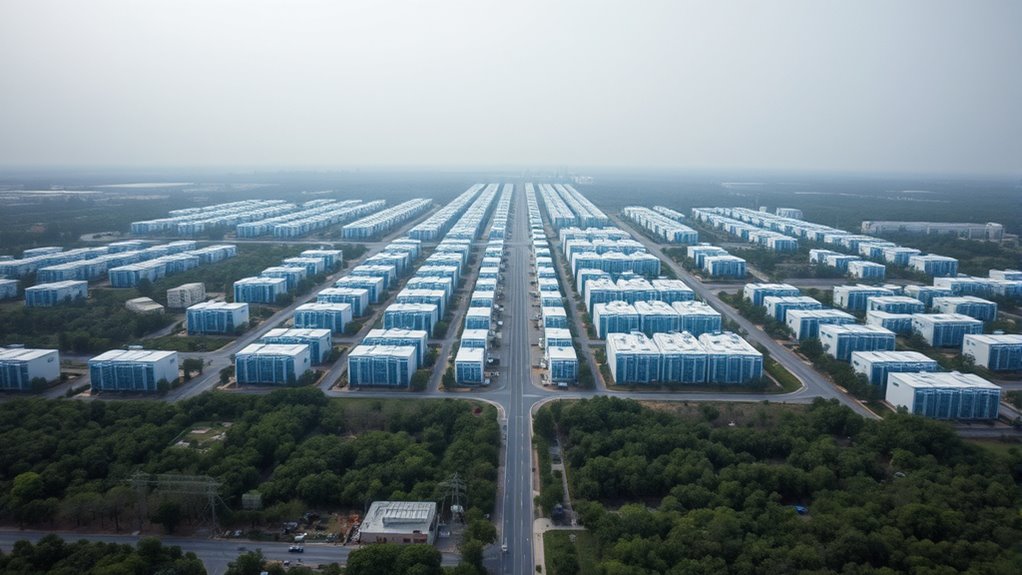As you explore the rapid growth of data centers, you’ll find that power, land, and policy constraints play key roles. The high energy demands challenge sourcing renewable and reliable power, while land availability limits expansion in some regions. Additionally, policies around land use and environmental impact can slow down new projects. Despite these hurdles, industry efforts focus on sustainable solutions and resilient infrastructure. To understand how these factors shape future growth, keep exploring the evolving landscape.
Key Takeaways
- Rapid data center expansion strains local power grids and highlights the need for renewable energy integration.
- Land scarcity and zoning policies limit site availability, complicating growth plans.
- Policy regulations and environmental restrictions can delay or restrict new data center projects.
- Reliance on renewable energy requires long-term power agreements amid fluctuating supply and demand.
- Infrastructure resilience and security demands increase complexity in land use and regulatory compliance.

Have you noticed how data centers are sprouting up around the world at an unprecedented pace? This rapid expansion isn’t just about meeting growing data demands; it’s also driven by the need for sustainable and resilient infrastructure. As these facilities multiply, powering them efficiently and sustainably becomes a top priority. You’ll find that many data center operators are increasingly turning to renewable energy sources to reduce their carbon footprint. Solar, wind, and hydroelectric power are no longer optional but essential components of their energy mix. By integrating renewable energy, you help guarantee that these centers operate more sustainably, aligning with global efforts to combat climate change. This shift isn’t just good for the environment—it also enhances infrastructure resilience. When data centers rely on diverse, renewable sources, they reduce dependency on traditional power grids that can be vulnerable to outages or disruptions. This diversification makes the infrastructure more robust against weather events, energy shortages, or grid failures, ensuring continuous operation and data security. Furthermore, investing in renewable energy can provide cost stability over time, shielding data centers from volatile fossil fuel prices. As you look at new data center projects, you’ll notice that developers prioritize locations with access to renewable resources, seeking to maximize energy efficiency and sustainability. They often collaborate with local utilities and renewable providers to establish dedicated power agreements, making their operations more self-sufficient and environmentally friendly. This approach not only helps meet corporate sustainability goals but also appeals to environmentally conscious clients and stakeholders. Infrastructure resilience is also more than just energy sourcing; it involves designing facilities to withstand physical and cyber threats. You’ll see that modern data centers incorporate advanced cooling systems, fire suppression, and security measures to protect their physical infrastructure. They also implement robust cybersecurity protocols to guard against cyberattacks that could cripple operations. Combining renewable energy with resilient infrastructure creates a synergy that helps data centers maintain uptime despite external shocks. Additionally, the integration of advanced energy management systems can optimize power usage and further enhance overall efficiency. All these efforts demonstrate a strategic shift towards sustainable growth, where power, land use, and policy constraints are addressed proactively. This evolution isn’t simple or quick, but it’s crucial for ensuring that the explosive growth of data centers doesn’t come at the expense of environmental integrity or operational stability. As someone involved in this industry or just observing it, you’ll see that the future of data centers hinges on their ability to leverage renewable energy and build resilient infrastructure, ensuring they support the digital economy sustainably for decades to come.
Frequently Asked Questions
How Are Data Centers Impacting Local Ecosystems and Wildlife?
You might not realize it, but data centers can disrupt local ecosystems and wildlife by causing habitat fragmentation and wildlife disruption. As they expand, they often encroach on natural habitats, displacing animals and fragmenting ecosystems. This can lead to decreased biodiversity and threaten species’ survival. While necessary for our digital age, it’s vital to take into account sustainable development practices to minimize these environmental impacts and protect local wildlife.
What Are the Long-Term Environmental Sustainability Strategies for Data Centers?
To guarantee long-term environmental sustainability, you should prioritize renewable energy sources to power data centers, reducing reliance on fossil fuels. Implement water efficiency measures, like advanced cooling technologies, to minimize water use. Regularly upgrade infrastructure with eco-friendly materials and optimize energy performance. By adopting these strategies, you help reduce your data center’s ecological footprint, supporting a greener future while maintaining operational efficiency.
How Do International Policies Influence Domestic Data Center Development?
International regulation and policy incentives profoundly influence your domestic data center development. Countries adopting strict environmental standards shape your local rules, pushing you toward greener practices. Policy incentives, like tax breaks or grants, motivate you to innovate and invest in sustainable infrastructure. These global guidelines and incentives create a framework that guides your decisions, ensuring your data centers align with international sustainability efforts while maximizing economic benefits and minimizing environmental impacts.
What Innovations Are Emerging to Reduce Energy Consumption in Data Centers?
You can reduce energy consumption in data centers by adopting AI optimization, which streamlines operations and improves efficiency. Additionally, renewable cooling technologies, like evaporative and geothermal systems, cut down on traditional energy use. These innovations help you lower your environmental impact, save costs, and meet sustainability goals. As you implement AI-driven management and renewable cooling solutions, you’ll see significant energy savings and a more eco-friendly data center operation.
How Do Economic Incentives Shape Data Center Location Decisions?
You consider economic incentives like tax incentives and land costs when choosing data center locations. These incentives can substantially lower your expenses, making certain regions more attractive. Lower land costs reduce initial investments, while tax breaks improve your long-term financial outlook. By analyzing these factors, you can optimize your location decision, balancing operational efficiency with cost savings and ensuring your data center remains competitive and sustainable.
Conclusion
As you navigate this data center boom, remember that the race for power, land, and policy is like a chess game—you must strategize wisely. The stakes are high, and the board is complex, but your choices can shape the future of our digital world. Embrace the challenge with foresight and resilience, for in this game of progress, the checkmate lies in sustainable, innovative solutions. The future’s in your hands—will you seize it?








